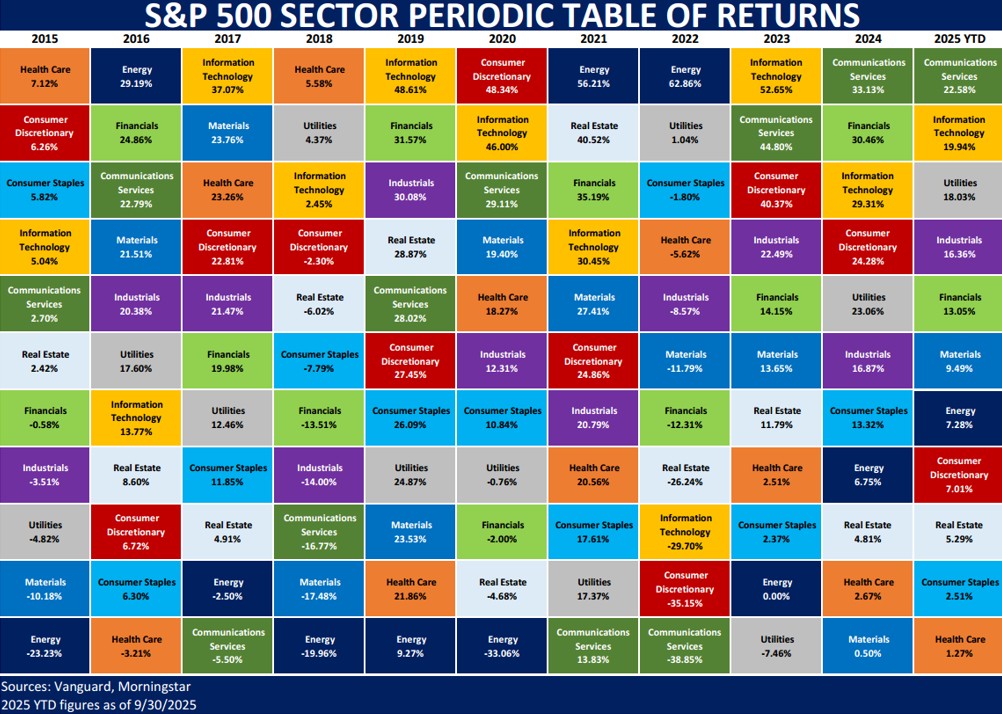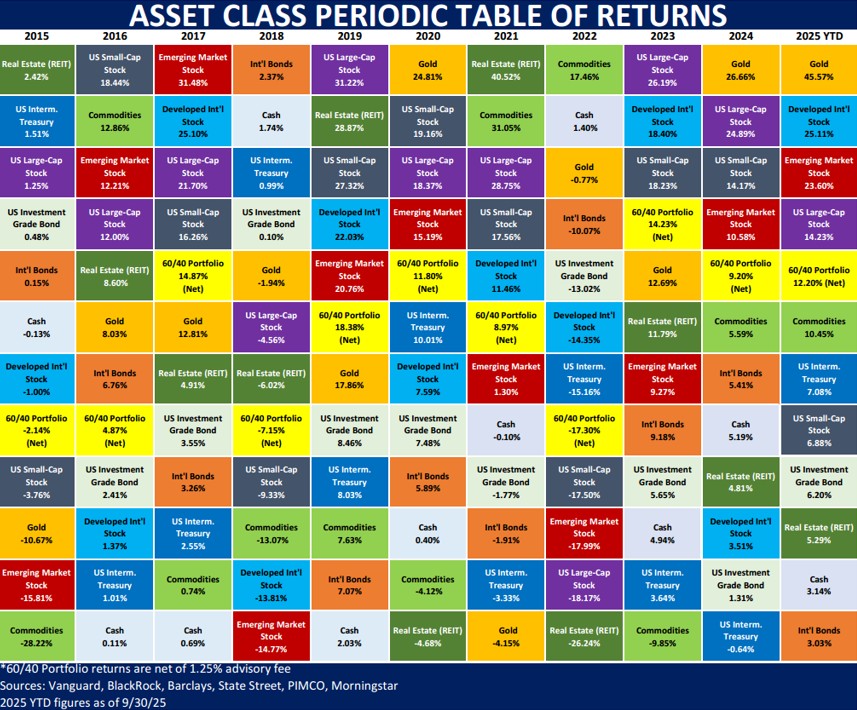Third Quarter 2025 Market Returns: S&P 500 Sectors & Asset Classes
In today's dynamic market, the factors driving returns are ever-changing. Our latest analysis underscores the value of a well-diversified portfolio by highlighting recent performance trends across S&P 500 sectors and asset classes. Explore the charts below to gain deeper insights into these trends and optimize your investment strategy with our expert guidance.
S&P 500 SECTOR PERIODIC TABLE OF RETURNS (2015 - 2025)
This chart contains the 11 sectors that constitute the S&P 500 Index. Each sector is given a unique color, and each column is organized from highest return (top) to lowest return (bottom), for a given year. The first 10 columns display annual performance for each sector from 2015 to 2024. The last column on the right illustrates year-to-date (YTD) performance, as of 9/30, for 2025.
2025 YTD Leaders:
- Communications Services = 22.58%
- Information Technology = 19.94%
- Utilities = 18.03%
2025 YTD Laggards:
- Health Care = 1.27%
- Consumer Staples = 2.51%
- Real Estate = 5.29%

ASSET CLASS PERIODIC TABLE OF RETURNS (2015 – 2025)
This chart is composed of 11 standard asset classes and an example of a diversified 60% stock and 40% bond portfolio. Each asset class is given a unique color, and each column is organized from highest return (top) to lowest return (bottom), for a given year. The 60/40 portfolio (in bright yellow) generally falls somewhere in the middle, helping to illustrate how a diversified portfolio can reduce volatility. The first 10 columns display annual performance for each asset class from 2015 to 2024. The last column on the right illustrates year-to-date (YTD) performance, as of 9/30, for 2025.
2025 Leaders:
- Gold = 45.57%
- Developed Int’l Stock = 25.11%
- Emerging Market Stock = 23.60%
2025 Laggards:
- Int’l Bonds = 3.03%
- Cash = 3.14%
- Real Estate (REIT) = 5.29%

Please feel free to reach out to us with any questions.
In today's dynamic market, the factors driving returns are ever-changing. Our latest analysis underscores the value of a well-diversified portfolio by highlighting recent performance trends across S&P 500 sectors and asset classes. Explore the charts below to gain deeper insights into these trends and optimize your investment strategy with our expert guidance.
S&P 500 SECTOR PERIODIC TABLE OF RETURNS (2015 - 2025)
This chart contains the 11 sectors that constitute the S&P 500 Index. Each sector is given a unique color, and each column is organized from highest return (top) to lowest return (bottom), for a given year. The first 10 columns display annual performance for each sector from 2015 to 2024. The last column on the right illustrates year-to-date (YTD) performance, as of 9/30, for 2025.
2025 YTD Leaders:
- Communications Services = 22.58%
- Information Technology = 19.94%
- Utilities = 18.03%
2025 YTD Laggards:
- Health Care = 1.27%
- Consumer Staples = 2.51%
- Real Estate = 5.29%

ASSET CLASS PERIODIC TABLE OF RETURNS (2015 – 2025)
This chart is composed of 11 standard asset classes and an example of a diversified 60% stock and 40% bond portfolio. Each asset class is given a unique color, and each column is organized from highest return (top) to lowest return (bottom), for a given year. The 60/40 portfolio (in bright yellow) generally falls somewhere in the middle, helping to illustrate how a diversified portfolio can reduce volatility. The first 10 columns display annual performance for each asset class from 2015 to 2024. The last column on the right illustrates year-to-date (YTD) performance, as of 9/30, for 2025.
2025 Leaders:
- Gold = 45.57%
- Developed Int’l Stock = 25.11%
- Emerging Market Stock = 23.60%
2025 Laggards:
- Int’l Bonds = 3.03%
- Cash = 3.14%
- Real Estate (REIT) = 5.29%

Please feel free to reach out to us with any questions.








.avif)



